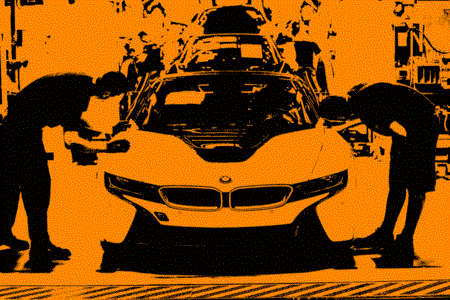video

The nation that invented the heart of the car at the dawn of the 20th century might struggle to adapt to the coming electric era.
By Elisabeth Behrmann
SHARE THIS ARTICLE
The completed combustion engine fitted into a BMW M5 is a 1,200-piece puzzle that weighs more than 400 pounds. There are about 150 moving parts whose interlocking precision can catapult a six-figure sports car to 60 miles per hour in 3.3 seconds. The engine hulking under the bright lights of the vast BMW factory hall in Dingolfing, Germany, has come together from a web of hundreds of suppliers and many, many hands.
The electric-vehicle motor produced in the same factory is different in almost every respect: light enough for a single person to lift, with just two dozen parts in total, and lacking an exhaust, transmission, or fuel tank. The battery cells themselves are mostly an industrial commodity, products bought in bulk from someone else. No one brags about the unique power of BMW’s electric drivetrain.
Yet this slight battery-driven motor can outgun the combustion engine in BMW’s fastest performance car from a standstill at a traffic light.
The fact that both combustion engines and electric motors find themselves inside the same 18,000-person complex in Dingolfing, BMW’s largest in Europe, makes it a microcosm of a shift overtaking automakers the world over. A visitor can see that 625-horsepower engine—more than twice as powerful as the original from 1985, a luxury product relentlessly branded as “the ultimate driving machine”—then walk around the corner and see its puny electric replacement. You start thinking the better slogan might be “the ultimate combustion engine.” As in: last of its kind.
Deep within Dingolfing you can find the human representations of the end of a 100-year technological era. These workers have electric flashes stitched onto their blue factory smocks, and their jobs are focused on the BMW i3—the company’s only all-electric model—as well as a lineup of plug-in hybrids. There were just a few employees marked with electric patches in a remote corner of the factory back when BMW first started gearing up for electric vehicles. Today, electric works occupy about 10 percent of Dingolfing.
In just a few years BMW will sell a dozen battery-powered models. The transition is already proving painful and expensive. Last month, expecting a 10 percent slump in profit this year, the company said it would begin a 12 billion-euro efficiency campaign to pay for this battery-focused revamp. Starting in 2021, meanwhile, BMW plans to eliminate up to 50 percent of drivetrain options. About a third of its 133,000-strong workforce has been trained to handle production of electric vehicles—and it’s clear that all of today’s employees won’t be necessary for tomorrow’s tasks.
Manuel Simeth has tried to make himself futureproof. He jumped into the new era ahead of most of his colleagues, earning an electric flash on his uniform to show he’s been trained to handle the dangers of working in a high-voltage environment. The father of two has a stubbly beard and stands over a neat stack of silver battery cells. He checks the fit of a black lid atop the power pack that will drive one of BMW’s electrified models.
Simeth ended up in batteries after facing the prospect of losing a previous job to a less-epochal change. BMW decided in 2012 to start sourcing car seats from outside suppliers, and the battery-assembly group then in its infancy seemed safer than staying put. “I’ve had the experience,” he says of working in a role that everyone knew would become outmoded and, inevitably, eliminated. “That's a depressing feeling.”